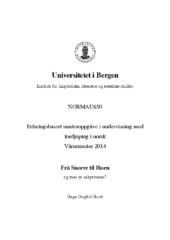Frå Snorre til Ibsen - og kvar er sakprosaen
Master thesis
Permanent lenke
https://hdl.handle.net/1956/8274Utgivelsesdato
2014-05-14Metadata
Vis full innførselSamlinger
Sammendrag
Denne masteroppgåva handlar om korleis lærebøkene i norsk på Vg2 studiespesialiserande løyser eitt av læreplanmåla i læreplanen frå LK06. Læreplanmålet handlar om at elevane skal lese tekstar frå mellomalderen og fram til 1870 i original og reflektere over språk og innhald. Eg har tatt utgangspunkt i fire lærebøker og undersøkt kva for forfattarar som er representerte, med kva for tekstar og om sakprosa har fått større plass enn før LK06. Omgrepet refleksjon gir føringar for korleis elevane skal jobbe med desse tekstane, difor har eg sett på korleis bøkene legg opp til lesinga av tekstane i form av oppgåvene som høyrer til. Norskfaget har gjennomgått store endringar sidan LK06 kom, og den siste store revisjonen kom hausten 2013. Det var difor naturleg at eg såg på diskusjonane som har vore i fagmiljøet vedkomande norskfaget. Eg er ikkje opptatt av å kome fram til sanningar, men ønskjer å sjå tendensar i samband med analysen, og for å finne ut av dette tar eg i bruk kritisk diskursanalyse. Primærkjeldene mine er, i tillegg til læreplanen i norsk, dei fire norskbøkene som er tilgjengelege på Vg2 studiespesialiserande: Spenn, Tema, Panorama og Grip teksten. Alle desse kom ut i 2007. Det eg fann var at lærebøkene er nokså like når det gjeld forfattarar som er representerte, men at tekstane kan vere noko forskjellig. Hovudvekta av tekstar før 1600-talet er ikkje norske, men europeiske. Det kan også sjå ut til at norrøne tekstar ikkje lenger har den store plassen som dei hadde før LK06. Sakprosatekstane er framleis i mindretal og i enkelte av bøkene er dei svært lite representert. Eg finn nesten ikkje sakprosatekstar frå før 1600- talet. Den sakprosaen elevane får presentert er også den som ligg nær skjønnlitteraturen som til dømes essay. Oppgåvene i bøkene har stor variasjon og det er mange av dei. Læreplanmålet ber elevane reflektere, men det er ikkje alltid at oppgåvene i bøkene ber om det same. Nokre oppgåver som vart kalla refleksjonsoppgåver var heller ikkje det. Lærebøkene ligg stort sett tett opp til læreplanen, men sakprosatekstar og oppgåver som ber om refleksjon har ikkje fått så mykje plass som dei burde. The topic of this master thesis is how textbooks in Norwegian Language and Literature solve one competence aim in the curriculum from LK 06 in Advanced Course 2. General Studies. This aim instructs the students to read a selection of significant texts from the Middle Ages to 1870 in its original language, and to reflect on language and content. I have studied four textbooks, which authors are represented in these books, and which texts they are represented with. I addition I have studied whether there is a greater focus on non-fiction texts after the introduction of LK06. The term reflection instructs the reader how to work with these texts. It has therefore been important for me to study the tasks related to the texts and how they influence the way students actually read these texts. The subject Norwegian has been through significant changes since the introduction of LK 06. The last revision was in the autumn of 2013. It was therefore interesting for me to take a closer look at the discussions within the discipline about this subject. My focus has been to find out how changes in curriculum have led to in changes in textbooks. I have primarily focused on tendencies, and I have not tried to give definite answers. My method has been the Critical Discourse Analysis, and my primary sources have, in addition to the Curriculum, has been the four textbooks available in Advanced Course 2, General Studies: Spenn, Tema. Panorama and Grip Teksten. All these textbooks came out in 2007. Looking at the authors represented in the books, I found the textbooks to be quite similar. However, they are not necessarily represented with the same texts. Most of the texts before 1600 are European, not Norwegian. There are also fewer texts in Old Norse after the LK06 reform. The non-fictional texts are still in minority compared to fiction, and in some of the books there are very few non-fictional texts. I have found almost no such texts from before 1600. Textbook tasks are many and varied, but although the intention is to make students reflect, sometimes reproduction and not reflection is the end result even though this is not intended. Overall the textbooks stay close to their interpretation of the curriculum, but there are relatively few non-fictional texts compared to fiction, and in addition there are in my opinion too few tasks that instruct students to reflect.
